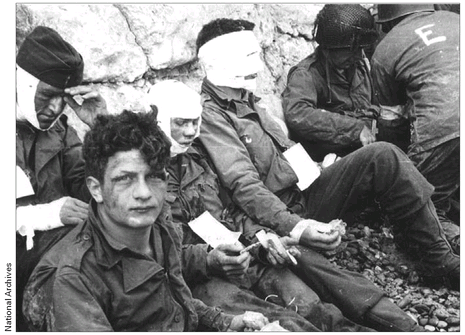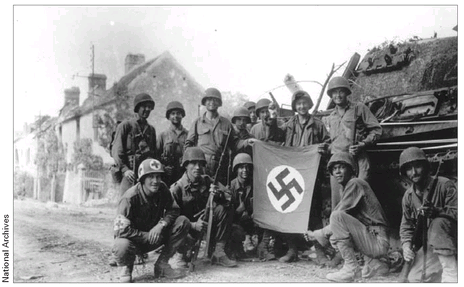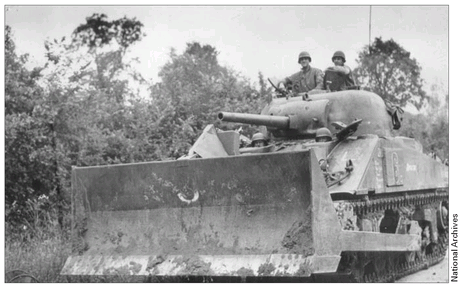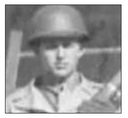War Stories III (33 page)
Authors: Oliver L. North

Â
Wounded Rangers are treated after they scaled the cliffs.

The Germans that Walt Ehlers would fight all the way into their homeland were slow to realize what was happening at Normandy. It was mid-morning before Field Marshall Erwin Rommel was even informed of the attack. He abruptly ended his visit to his wife in Germany and hastened back to Normandy.
Hitler wasn't told about the invasion until even laterâhis military advisors and commanders were afraid to wake him. He didn't get up on D-Day until close to noon, and it was four in the afternoon before Hitler decided to release two Panzer divisions for a counter-attack. By then it was too late.
By nightfall on D-Day the Allies had landed over 150,000 troops on the five invasion beaches. There were more than 5,000 Allied casualties, but they had cracked Hitler's Atlantic Wall. Within days, a quarter of a million more men, thousands of tanks, trucks, and nearly a million tons of supplies would be pouring into Fortress Europe. And Dwight Eisenhower's unsent message accepting responsibility for a disaster at Normandy would wait four years before becoming public.
CHAPTER 12
FREEING FRANCE FROM HITLER 1944
H
itler's delayed reaction to Overlord cost the Wehrmacht dearly. By the morning after D-Day, the breach in his Atlantic Wall was all but irreparable. Despite horrific American casualties at Omaha on 6 June, the Führer's belated release of the 12th SS Panzer and Panzer Lehr Divisions meant that the German armor, now under repeated attack from the air, would be unable to prevent consolidation of the Normandy beachheads. By 10 June, Eisenhower landed sufficient forces to close the gaps and connect the separate British, Canadian, and American lodgments.
itler's delayed reaction to Overlord cost the Wehrmacht dearly. By the morning after D-Day, the breach in his Atlantic Wall was all but irreparable. Despite horrific American casualties at Omaha on 6 June, the Führer's belated release of the 12th SS Panzer and Panzer Lehr Divisions meant that the German armor, now under repeated attack from the air, would be unable to prevent consolidation of the Normandy beachheads. By 10 June, Eisenhower landed sufficient forces to close the gaps and connect the separate British, Canadian, and American lodgments.
While German reinforcements struggled to get to the battle at the Normandy beachhead, Hitler turned to his “secret weapons.” On 12 June he launched the first V-1 “Buzz Bomb”âa crude version of the modern cruise missileâagainst London. Though nearly half of the eighty V-1s per day that were launched against England misfired or went awry, the Führer believed that the weapons could save Germanyâeven after an errant missile hit his headquarters bunker on 17 June during his only visit to the Normandy front, hardly a good sign.
Â
U.S. soldiers celebrate after liberating Chambois.

Then on 19 June Hitler got some unexpected helpâfrom the weather. A fierce, three-day-long Atlantic storm grounded Allied air power, allowing German armor reserves to move into position around Caen. High waves struck the Allies' artificial harborsâsmashing Mulberry B at Omaha beach and damaging Mulberry A at Gold. The British effected quick repairs and were able to resume offloading troops and 11,000 tons of equipment and supplies daily, but the American Mulberry was destroyedâalong with nearly 300 ships and landing craft. The storm did what the crippled Luftwaffe could not accomplish. For weeks thereafter, the Americans were forced to laboriously transfer personnel and materiel into small landing craft for deliveries ashore.
Despite these setbacks, less than three weeks after D-Day, the Allies had landed almost a million menâtwenty-five divisionsâat Normandy. And fifteen more divisions in England were ready to “come across” to back a breakout from the hedgerows of
bocage
country.
bocage
country.
Despite years of Allied over-flights and intelligence collection in France, no U.S. or American commander had anticipated how difficult it would be to break through the nearly impregnable hedgerows that divided the Normandy
farmland into 100- to 200-yard-wide rectangles. Comprised of earth, tangled roots, and vegetation, the banks were often ten feet thick and equally high. Impervious to artillery, tank, and small-arms fire, the
bocage
were perfect defensive barriers, providing excellent cover and concealment for well-camouflaged German defendersâwho turned the fields between them into death traps for the American, British, and Canadian attackers.
farmland into 100- to 200-yard-wide rectangles. Comprised of earth, tangled roots, and vegetation, the banks were often ten feet thick and equally high. Impervious to artillery, tank, and small-arms fire, the
bocage
were perfect defensive barriers, providing excellent cover and concealment for well-camouflaged German defendersâwho turned the fields between them into death traps for the American, British, and Canadian attackers.
Â
Bulldozer tank

In the period 12 Juneâ1 July, three British/Canadian offensives against the main German defenses at Caen foundered in the narrow roadways, canals, and hedgerows along the coastal plain. On the Cotentin Peninsula, the U.S. 29th, 4th, 9th, and 90th Divisions were all bloodied by battles in the
bocage
. When they finally broke through and captured Cherbourg on 26 June, the port Eisenhower had counted on utilizing immediately was rendered unusable. What the Allied bombing and artillery hadn't already destroyed, the 6,000-man German garrison demolished before they surrendered.
bocage
. When they finally broke through and captured Cherbourg on 26 June, the port Eisenhower had counted on utilizing immediately was rendered unusable. What the Allied bombing and artillery hadn't already destroyed, the 6,000-man German garrison demolished before they surrendered.
The night Cherbourg fell, General Friedrich Dollman, commander of the Wehrmacht 7th Army, committed suicide. On 3 July, after Hitler ordered courts martial for all involved in the loss of Cherbourg, von Rundstedt urged the Führer to sue for peace. The old Prussian general was fired
immediately and replaced by Field Marshal Gunther von Kluge the next day. Little more than a month later von Kluge would also be dead at his own handâon 18 August he committed suicide after being implicated in the plot to kill Hitler.
immediately and replaced by Field Marshal Gunther von Kluge the next day. Little more than a month later von Kluge would also be dead at his own handâon 18 August he committed suicide after being implicated in the plot to kill Hitler.
By 3 July, the Americans had secured the entire Cotentin Peninsula and began to push south. The new objective: St. Lôâa strategically important crossroads and railhead on the banks of the River Vire. Eisenhower, Montgomery, and Bradley believed that if St. Lô could be captured quickly, the long-sought breakout into open French countryside could alleviate the pressure on the British and Canadians at Caen.
Taking and holding St. Lô required that the Allies seize and secure Hill 192, the dominant terrain feature in the area. On 11 July, a company of the Wehrmacht's elite 3rd Parachute Division held this commanding terrain. The mission of capturing it fell to the 38th Infantry Regiment of the 2nd Division. One of the platoon commanders in that bloody fight was twenty-two-year-old Lieutenant Charles Curley from Virginia.
LIEUTENANT CHARLES CURLEY
Company E, 2nd Battalion, 38th Infantry,
2nd Infantry Division
Hill 192, Normandy, France
11 July 1944
2nd Infantry Division
Hill 192, Normandy, France
11 July 1944

Hill 192 really is not a big hillâit's only six hundred feet above sea levelâbut from the top of it you could see the English Channel and the rest of the countryside for miles aroundâincluding all the approaches to St. Lô. The Germans needed to hold it for their artillery forward observersâbecause they didn't have aerial observers flying over the battlefield like we did. A German parachute infantry company was holding this high ground and really meant to keep it.
We were ordered to take the hill, but to get to it we had to cross five hedgerows. These hedgerows were five to fifteen feet tallâsix to ten feet
wide at the baseâand full of rocks, trees, and roots. We tried to dig into them to set up a base of fire but it was almost impossible. The army demolition engineers tried using TNT, put it on the ground, and blew that first hedge. There was a terrific explosion. Stuff went up into the air but when the smoke cleared, the hedgerow was still there. I told the engineers to stop because every German artillery forward observer for miles around could see these explosions and know right where to zero in on us.
wide at the baseâand full of rocks, trees, and roots. We tried to dig into them to set up a base of fire but it was almost impossible. The army demolition engineers tried using TNT, put it on the ground, and blew that first hedge. There was a terrific explosion. Stuff went up into the air but when the smoke cleared, the hedgerow was still there. I told the engineers to stop because every German artillery forward observer for miles around could see these explosions and know right where to zero in on us.
The Germans usually stuck a machine gun right in a corner of the field opposite the hedgerow we were trying to get through, over, or around. The machine gun field of fire would cover the entire open field between them and us. And they knew we'd try to cross that field.
I developed a way of dealing with that. As we got ready to cross a field toward the next hedgerow, I'd call up a tank and have it stick its gun through the hedge and blast the corners of the hedgerow on the far side of the field. I would do that each time, regardless of whether we saw anything there or not. More often than not, the tank rounds would take out a machine gun that would have cut us down.
Eventually some bright soldier developed what we called the “Dozer-Tank”âit was a Sherman tank equipped with a bulldozer blade. With a couple of those we could punch holes right through the hedgerows for both the tanks and the infantrymen to go through.
When we got to the base of Hill 192, I deployed my platoon in a skirmish line and hunkered down while the forward observers called in fire. The barrage must have lasted an hourâwith 105s, 155s and 8-inch guns blasting the hillsideâover 20,000 rounds I'm told. But as soon as it stopped and we launched the attack, the German machine guns and mortars opened up on us. I had two killed, and two wounded. Some of the other units had ten or fifteen killed and a whole lot more wounded. We ended up taking Hill 192 by brute force.
Between Hill 192 and the center of St. Lô there was about eight kilometers of hedgerows and little villages. We had to take every hedgerowâand every house on the way into St. Lôâone at a time and the Germans fought back at every one of them. I lost one of my sergeants, a squad
leader, when he got shot after climbing up on a hedgerow to shoot down on some Germans digging in on the other side.
leader, when he got shot after climbing up on a hedgerow to shoot down on some Germans digging in on the other side.
As we got closer to St. Lô, the Germans were employing mines in the edges of the narrow roads to take out our tanks. The only way to deal with that problem is to have infantry out in front of the tanks to check for mines. As we approached one of these little villages outside of St. Lô I was walking point in front of a “buttoned up” Shermanâmeaning all his hatches were closedâwhen I spotted a German Mark IV Panzer up ahead. I ran back to our lead tank to point out the German tank and was right in front of him when an enormous explosion went off just over my head. My helmet went flying and so did I. The gunner, who hadn't seen meâor the German tank I was trying to point outâhad fired the main gun at a sniper up ahead. I can't believe it didn't blow out my eardrums. I couldn't hear for a while.
It took us eight days to take St. Lôâand by the time we got control of the city, it was in ruins. We all knew then that kicking the Germans out of France was going to be a very tough fight.
St. Lô was liberated on 18 Julyâthe day after Rommel was severely wounded by an Allied air attack near Caen. Though Bradley wanted to press on, his 1st Army had suffered some 40,000 casualties in two weeks of combat. He had no choice but to pause the offensive while reinforcements, replacements, and fresh supplies were sent forward to the spent troops.
Other books
041 Something to Hide by Carolyn Keene
Denver: A Bad Boy Romance (FMX Bros Book 3) by Oliver, Tess
Leon | a Bad Boy MC Motorcycle Club Romance by Rose Cody
Hunger and Thirst by Richard Matheson
Faces of Fear by Graham Masterton
The Blood That Bonds by Christopher Buecheler
The Unwilling Bride by Jennifer Greene
Penumbra (The Midnight Society #2) by Logan Patricks
Bridenapped: The Alpha Chronicles by Georgette St. Clair
Identical by Ellen Hopkins
